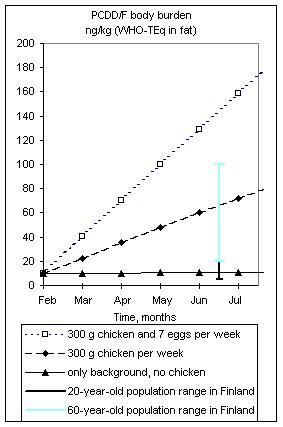Belgian chicken incident
This page is a encyclopedia article.
The page identifier is Op_en3449 |
|---|
| Moderator:Henrik (see all) |
|
|
| Upload data
|
Belgian chicken incident: a food contamination incident in Belgium. In January 1999 a large tank of recirculated fats was contaminated probably by PCB oil. Refined fat was sold to more than ten animal feed factories (the contaminated lot probably only to two factories, both in Belgium), which again sold their contaminated feed to farms, mostly chicken farms. The problem was noticed when the chickens showed symptoms of toxicity: low fertility and deformed chicks.
The total amount of PCB oil has been evaluated as 40–50 kg containing about 1 g (WHO-TEq) of dioxins and about 2 g (WHO- TEq) dioxin-like PCBs (Debacker et al., Chemosphere 2007:67:S217–S223, [1]). This could be the content of one or a few transformers.
The contamination of chicken feed is essentially a PCB problem, not a primary dioxin problem. The amount of PCB oil, causing the measured concentrations in the animal feed need not be more than about 10 litres. This could be the content of one or a few transformers. The highest concentrations of PCBs found in chicken fat have been 51 mg/kg (Σ7PCB in fat) (51,000 ng/g) (seven marker PCBs), and the highest dioxin concentration 0.0026 mg/kg (2,613 ng/kg, as I-TEq or TCDD-equivalents in fat). PCBs have later (in summer 1999) been found also in pork, but not in milk at concentrations above the general background. In chicken or chicken feed samples there were 50,000 times more PCBs (Σ7PCB) than dioxin-TEqs, and the ratio is fairly constant. This means that monitoring in this specific case can be based on PCBs. As a screening analysis this can be performed in many laboratories, whereas dioxin analysis is extremely difficult and there are very few laboratories in Europe capable of performing them reliably. Also the cost of dioxin analysis is prohibitively expensive (of the order of 1000 euro per sample) and the analysis is time-consuming (about 1 month). Therefore routine monitoring cannot be based on dioxin analyses or congener-specific PCB analysis using mass spectrometry.
Figure 1. Modelled increase in the body burden of a person who consumes continuosly the worst-contaminated chicken from Belgian chicken incident. A, six-month follow-up; B, 70-year follow-up. Assumptions: half-life: 8.6 years, body fat content: 15 kg, PCDD/F concentration in chicken: 1000 ng/kg (TEq in fat), chicken fat content: 15 % (per wet weight).
Risk evaluation
Dioxin concentrations that exceed the accepted limits in extreme cases by a hundredfold or more would cause a highly increased body burden in human beings, but slowly. Consuming 150 g of contaminated chicken (assuming 1000 ng/kg I-TEq in fat, 15 % of fat in the meat) twice a week would produce a body burden that would be hundredfold as compared with the present body burden of population (Figure 1). This would, however, require a continuous consumption during 30 to 50 years (see Cumulation). In fact, an increase of 20 ng/kg (I-TEq in fat) would require 1 to 2 months of continuous consumption. Because the average young adult concentration in Central Europe in the period 1987 to 1993 decreased from 40 ng/kg to 20 ng/kg, the calculated consumption for one month would mean going back to the levels prevalent in population during the 1980s.
Because it is unlikely that an individual would consume the worst contaminated chicken from week to week at this level, the true population effect is much less. There may, however, be individuals who eat contaminated products from a single farm for some reason, and among those this prediction might hold. Even in such a case This was later confirmed by actual measurements, where the congeners specific to the contamination were traceable, but WHO-TEq values in the population did not increase significantly, in fact only from 22.9 to 23.1 ng/kg (Debacker et al., Chemosphere 2007:67:S217–S223, [2]). the time factor excludes any dramatic effects of dioxins. The contribution of non-dioxin-like PCBs is more difficult to assess. Particularly their poorly characterised neurodevelopmental effects are of concern. Also these compounds accumulate slowly. The incident shows that due to the slow cumulation of dioxins, long-term control of food is of paramount importance, and probably should be reconsidered in the European Union. It also seems that the recirculation and reuse system of fats, which as such is ecologically sound in reducing waste, is too open and vulnerable.
This risk evaluation means that food control should be very strict, and monitoring of concentrations in exposed population groups are highly advisable, but no individual health measures in those people who have consumed contaminated chicken for a limited time period can (nor need to) be recommended.

